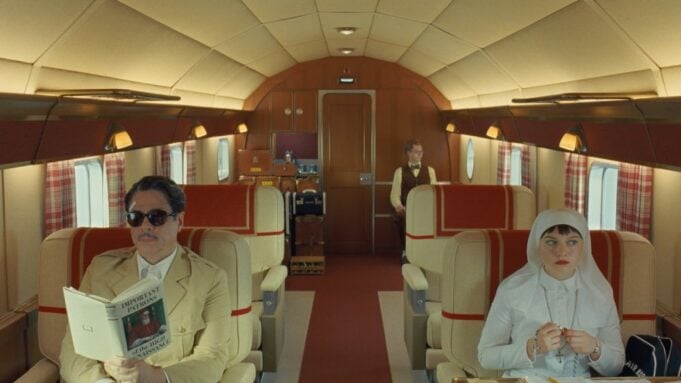There was a time when wealthy businessmen like Wes Anderson’s fictional Zsa-zsa Korda bent the rules, amassed their fortunes and quietly plotted out the succession plans for the dynasties they had built. Now, such men run countries, though one shouldn’t read too strong a political message into Anderson’s latest divertissement, “The Phoenician Scheme.” A tongue-in-cheek look at one such titan, the dense but undeniably enjoyable saga doubles as a moving father-daughter tale and ultimately seems far more interested in exploring the robber baron spirit of 20th-century capitalism than its consequences.
Inspired by the likes of J. Paul Getty, J.P. Morgan and Anderson’s late father-in-law, Lebanese construction mogul Fouad Mikhael Malouf, “The Phoenician Scheme” promotes Benicio del Toro from bit player (the incarcerated artistic genius in 2021’s “The French Dispatch”) to protagonist in the Anderson universe. Meanwhile, Mia Threapleton marks the most significant new addition to the helmer’s ever-expanding company, appearing as Zsa-zsa’s porcelain-faced daughter (and novitiate nun), Leisl.
A shave and a haircut suit del Toro nicely: The actor comes off positively dignified as Korda, a cultivated wheeler-dealer with a streak of the ruffian in him. Sporting bespoke double-breasted suits, slicked-back salt-and-pepper hair and a wooden crate of hand grenades wherever he goes, Korda belongs to no country in particular, but has business in many. He’s a controversial figure, wanted dead by at least one of his innumerable rivals.
The movie opens with composer Alexandre Desplat injecting a dose of Lalo Schifrin-esque suspense into a low-altitude flight, as Korda calmly reads the sort of highly specialized nonfiction book that would put most men to sleep, when an explosion tears through the fuselage of his private plane. It’s a relatively spectacular opening by Anderson standards, even if the crash is depicted in one of those traveling shots where the camera tracks alongside the smoldering remains of the plane slowly enough for audiences to chuckle at the sight of Korda’s possessions scattered across a cornfield.
This latest brush with death has left Korda with two priorities: to make amends with his estranged daughter, who still hasn’t forgiven Zsa-zsa for whatever part he played in her mother’s death, and to push through his most ambitious venture yet. It’s a three-part infrastructure project consisting of a Trans-mountain Locomotive Tunnel, a Trans-desert Inland Waterway and a Trans-basin Hydroelectric Embankment, the specifics of which are about as interesting as those three titles make them sound.
As Korda tries to cover a funding gap that could crater his plans, most of “The Phoenician Scheme” is spent crisscrossing a fictional country (Modern Greater Independent Phoenicia) loosely inspired by the Arabian Peninsula, with Leisl and her twerpy Swedish tutor Bjorn (Michael Cera) in tow. The year is 1950, roughly halfway between the release dates of “Citizen Kane” and “Lawrence of Arabia,” and the spirit of those two icons echoes here, albeit on the miniaturist scale that suits Anderson best. Like so many of the filmmaker’s stuffed-shirt patriarchs, from Royal Tenenbaum to Steve Zissou, Korda is a figure of both admiration and ridicule — an ironic posture that allows Anderson to sneak in a dose of sincerity alongside caricature.
Less conceptually quirky than the eccentric auteur’s recent “Asteroid City” (with its film-within-a-stage-rehearsal-within-a-“Playhouse 90”-esque-TV-special meta framing), but no less profound, “The Phoenician Scheme” once again finds Anderson incorporating existential matters into a seemingly satirical form. Not a frame goes by without myriad comedic details to tickle his audience, and yet beneath it all, the director dares to confront questions of mortality. Front and center here is Korda’s almost Dickensian dilemma: If he’s dedicated all his energy to amassing wealth but missed out on family, what use did his fortune serve?
Love Film & TV?
Get your daily dose of everything happening in music, film and TV in Australia and abroad.
When Liesl reenters his life, Zsa-zsa hasn’t yet come around. He sits her down and explains that should one of his enemies succeed in eliminating him, the Korda estate will pass to her — not that this future nun should see much need for it, fully intending to renounce all worldly possessions when she takes her vows. He then proceeds to show her the extent of his operations, neatly categorized in a series of shoeboxes and laid out on the floor in Anderson’s geometrically obsessive-compulsive style. (The director outdoes himself with some of his meticulous compositions here, including an overhead shot of Korda’s bathroom that perfectly fills the frame.)
What interest could accompanying Zsa-zsa on a six-stop business junket hold for Leisl? Or us, for that matter? At times, “The Phoenician Scheme” can feel about as much fun as watching a gifted accountant navigate the loopholes of corporate tax law, given Anderson’s newfound preoccupation with contractual intricacies and arcane financing arrangements, which in the film are constantly being renegotiated via basketball games and backroom deals. But don’t forget that’s merely the MacGuffin, while the rapprochement between Leisl and her cad of a dad is the main attraction here.
The director pulls in A-list stars he’s worked with before (Tom Hanks, Bryan Cranston, Mathieu Amalric, Scarlett Johansson and a weird-bearded Benedict Cumberbatch) to play the various parties Korda must convince to plug some percentage of the gap. But Korda, whose lines del Toro delivers with the same measured cadence Bill Murray has brought to various Anderson roles, is too perturbed by mystic visions to focus entirely on the task at hand. On five occasions, typically brought on by near-death scrapes, Zsa-zsa imagines himself in black-and-white dream sequences, stylized to look like scenes from a Sergei Parajanov movie (picture “The Color of Pomegranates,” minus the color, with cameos from Murray, Willem Dafoe and Charlotte Gainsbourg).
Before dismissing these interludes as absurd, consider just how much care Anderson has put into every composition. It all means something, although far be it from most audiences to decipher the director’s obscure symbolism. The same could be said for the museum-quality works of art sprinkled throughout the film. “Never buy good pictures. Buy masterpieces,” Korda decrees, speaking on behalf of all those tycoons (from Getty to Hearst) who spent their fortunes hoarding treasures.
That’s one kind of legacy, although Anderson seems to be directing the movie’s meaning-of-life inquiry at himself, as an artist and a father, not to mention the husband of someone with a Korda-like dad. Anderson’s style is nothing if not personal, in that no one but he could imagine such elaborate worlds, and yet this is what’s been missing from his more superficial-minded early features: a measure of introspection, which puts Korda’s infernal business dealings into proper perspective.
From Variety US































